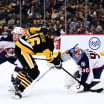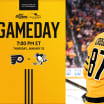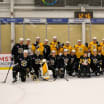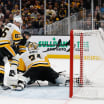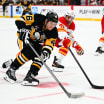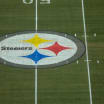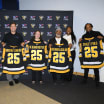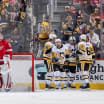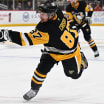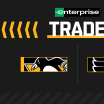The Penguins have played in a number of outdoor games in recent years, and they've worn special jerseys on each occasion. But the jersey that Pittsburgh is going to wear for the 2023 Winter Classic, set for Jan. 2 at Fenway Park, is particular unique - with the story behind the logo not known by many.
Penguins' Winter Classic Logo Pays Homage to 1925 NHL Pirates
Here's the story behind Pittsburgh's original NHL franchise
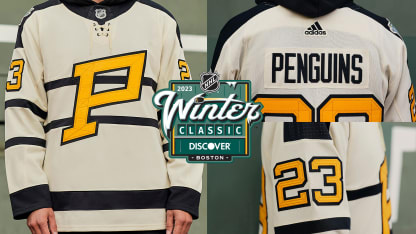
By
Michelle Crechiolo
Penguins Team Reporter
"I see that logo as an homage to the rich history of Pittsburgh hockey," said Jim Kubus, who covered the Penguins for 30 years with the Tribune-Review, and runs the popular historical website pittsburghhockey.net.
"It's nice it acknowledges it, and it causes conversations like this to be stimulated where it's like, 'oh, I didn't realize that.' The Crosby generation is probably going to learn about this for the first time, which is awesome."
The logo is inspired by the city's original NHL franchise, the Pittsburgh Pirates, who entered the league for its ninth season back in 1925. And at that time, hockey was actually quite popular in Pittsburgh.
There was a building called the Schenley Park Casino in Oakland which had an artificial ice surface that attracted players from Canada. There was also Duquesne Gardens, which was billed as the biggest skating rink in the world when it opened in 1899 - and had the honor of hosting tryouts for the first-ever U.S. Men's Olympic Team ahead of the 1920 Winter Olympics.
It was also home to the Pittsburgh Yellow Jackets of the United States Amateur Hockey Association. The team had plenty of success on the ice, winning consecutive championships in 1924 and '25. But complications off the ice forced owner Roy Schooley to sell the team to Pittsburgh attorney James Callahan and Duquesne Gardens president Henry Townsend.
Callahan wanted to start an NHL franchise, and they became one for the 1925-26 campaign. While much of the roster remained the same, with about 60% of the members playing for the Yellow Jackets the previous season, the name did not. Callahan hoped to capitalize on the momentum of the National League's Pirates, getting permission to give the hockey team that same name.
"The Pirates won in 1909 and 1925, so they were they were popular, and it was pre-Steelers," Kubus said. "Baseball ruled the United States in terms of sports."
The NHL Pirates were one of seven teams in the league, joining the Montreal Canadiens, Montreal Maroons, Ottawa Senators, Toronto St. Patricks, New York Americans, and of course, the Boston Bruins.
"It dovetails nicely because the first NHL game played by a Pittsburgh team was against a Boston team," Kubus said. "It was in Boston; Pittsburgh won that game."
The Pirates followed that up with a 1-0 victory against the Canadiens in Montreal before returning to Pittsburgh for their first-ever home game. It took place on Dec. 2, 1925, against the Americans, who were the other expansion team that season. Lionel Conacher, who was posthumously inducted into the Hockey Hall of Fame in 1994, scored the first-ever NHL goal for a Pittsburgh team in their 2-1 overtime loss.
"When the Pirates came in, their opening night must have been filled to the gills," Kubus said. "The capacity, as near as we can determine, was a little over 5,000. So, looking at some of the box scores - they weren't very consistent about reporting attendance, and it may have been like the reporter just kind of leaning out and taking a guess (laughs) - but it was at least at half capacity for that first season. So you're talking around 2,500 to 3,000 people that used to come out to watch the Pirates."
The Pirates ended up playing five total seasons in the NHL through the 1929-30 season before ownership changes, the stock market crash and the Great Depression forced the team to leave town. It would be another 37 years before NHL hockey returned to Pittsburgh, when Jack McGregor led the charge to found a team as part of the 1967-68 expansion … and named them the Penguins.
One part of the Pirates legacy that most people do know, is that they set the precedent which allowed the Penguins to switch from blue to black and gold over a decade into their existence. The Pirates hockey team was actually the first professional team in Pittsburgh to don those colors, as the Pirates baseball club wore blue and red, and the Steelers didn't form until 1933.
With the Steelers winning the Super Bowl and the Pirates capturing the World Series title in the same year, the Penguins hoped to gain fan support with aligning their colors with the other teams in the "City of Champions," wearing black and gold for the first time on Jan. 30, 1980.
Boston protested the color change to the NHL, arguing that black and gold had always been exclusively associated with the Bruins. However, the Penguins prevailed by virtue of the Pirates precedent.
Now, the two teams will meet at Fenway Park in jerseys that feature identities wholly new to hockey fans while still inspired by the authentic hockey histories of each home city.
"It's a really nice stick tap to what came before," Kubus said.




